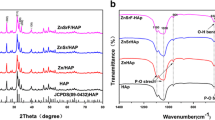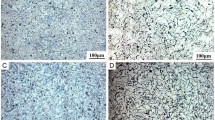Abstract
It is commonly accepted that silicon-doped hydroxyapatite (HAp) can achieve good repair effects for both spinal fusion and bone defect filling. However, the underlying mechanism by which silicon aids such beneficial effects is still not fully understood. Herein, we report on silicon-doped hydroxyapatites with excellent biocompatibility to osteoblast cells and suggest the signaling pathway involved. Non-doped HAp and trace Si-doped HAp (Si/HAp) with Si concentration close to and higher than natural bones were synthesized (i.e., 32, 260, and 2000 ppm Si). The composition, crystal lattice vibration pattern, and morphology of these samples are characterized by X-ray diffraction (XRD), Fourier transform infrared (FTIR), and SEM, respectively. Positive biological activities of these Si-doped HAp materials were demonstrated through a cytotoxicity study and with the MTT and alkaline phosphatase (ALP) activity assays. The Si-doped samples were not toxic to MC3T3-E1 cells. Indeed, osteoblast proliferation measurement illustrated that 2000 ppm Si-doped HAp increased osteoblast proliferation by about 1.6 times compared to non-doped HAp. The ALP assay also proves that the trace Si doping has the function to enhance cell proliferation and differentiation. The ALP assay showed that Si doping also enhanced cell differentiation. QRT-PCR results revealed that Si-doped HAp enhanced osteogenic differentiation of osteoblast cells by upregulating genes such as MAPK3, Fzd1, Wnt1, Lrp6, and BMP2. In conclusion, Si-doped HAp promotes osteoblast proliferation and differentiation by activating the Wnt/β-catenin and MAPK signaling pathways. This work could provide useful information of the beneficial effects of silicon in human bones and provide clues as to the molecular mechanism of the promotive effect of Si-doped HAp biomaterials.













Similar content being viewed by others
References
Blumenthal NC, Betts F, Posner AS (1975) Effect of carbonate and biological macromolecules on formation and properties of hydroxyapatite. Calcif Tissue Res 18(2):81–90. doi:10.1007/bf02546228
Patel N, Best SM, Bonfield W, Gibson IR, Hing KA, Damien E, Revell PA (2002) A comparative study on the in vivo behavior of hydroxyapatite and silicon substituted hydroxyapatite granules. Journal of Materials Science-Materials in Medicine 13(12):1199–1206. doi:10.1023/a:1021114710076
Gao J, Wang M, Shi C, Wang L, Wang D, Zhu Y (2016) Synthesis of trace element Si and Sr codoping hydroxyapatite with non-cytotoxicity and enhanced cell proliferation and differentiation. Biol Trace Elem Res 174(1):208–217. doi:10.1007/s12011-016-0697-0
Qiu Z-Y, Noh I-S, Zhang S-M (2013) Silicate-doped hydroxyapatite and its promotive effect on bone mineralization. Front Mater Sci 7(1):40–50. doi:10.1007/s11706-013-0193-9
Mueller WEG, Wang X, Grebenjuk V, Diehl-Seifert B, Steffen R, Schlossmacher U, Trautwein A, Neumann S, Schroeder HC (2013) Silica as a morphogenetically active inorganic polymer. Biomaterials Science 1(6):669–678. doi:10.1039/c3bm00001j
Forresth N (1984) Ultratrace elements in nutrition. Annu Rev Nutr 4(1):21
Carlisle EM (1972) Silicon: an essential element for the chick. Science 178(4061):619
Carlisle EM (1981) Silicon in Bone Formation. Springer, New York
Huang Z (1994) Silicon measurement in bone and other tissues by electrothermal atomic absorption spectrometry. J Anal At Spectrom 9(1):11–15
Jugdaohsingh R, Pedro LD, Watson A, Powell JJ (2015) Silicon and boron differ in their localization and loading in bone. Bone Reports 1:9–15
Cichoke AJ (1995) Silicon. Total Health 17(3):28
Linton KM, Shore RC, Aaron JE (2006) Distinctions in mineral morphology and magnesium and silicon content between osteoporotic and osteoarthritic bone. In: Meeting of the Bone-Research-Society; pp. 1163–1163
Iyengar GV (1985) Concentrations of 15 trace elements in some selected adult human tissues and body fluids of clinical interest from several countries: results from a pilot study for the establishment of reference values. Instit Med Juelich Nuclear Res Center D-517, Juelich, Fed. Rep. Ger
Schwarz K, Milne DB (1972) Growth-promoting effects of silicon in rats. Nature 239(5371):333
Arcos D, Rodríguez Carvajal J, Vallet Regí M (2004) Silicon incorporation in hydroxylapatite obtained by controlled crystallization. Chem Mater 16(11):2300–2308
Qiu ZY, Li G, Zhang YQ, Liu J, Hu W, Ma J, Zhang SM (2012) Fine structure analysis and sintering properties of Si-doped hydroxyapatite. Biomed Mater 7(4):045009
Tian T, Jiang D, Zhang J, Lin Q (2008) Synthesis of Si-substituted hydroxyapatite by a wet mechanochemical method. Materials Science & Engineering C 28(1):57–63
Botelho CM, Brooks RA, Best SM, Lopes MA, Santos JD, Rushton N, Bonfield W (2006) Human osteoblast response to silicon-substituted hydroxyapatite. J Biomed Mater Res A 79A(3):723–730. doi:10.1002/jbm.a.30806
Palard M, Combes J, Champion E, Foucaud S, Rattner A, Bernache-Assollant D (2009) Effect of silicon content on the sintering and biological behaviour of Ca-10(PO4)(6-x)(SiO4)(x)(OH)(2-x) ceramics. Acta Biomater 5(4):1223–1232. doi:10.1016/j.actbio.2008.10.016
Gomes PS, Botelho C, Lopes MA, Santos JD, Fernandes MH (2010) Evaluation of human osteoblastic cell response to plasma-sprayed silicon-substituted hydroxyapatite coatings over titanium substrates. Journal of Biomedical Materials Research Part B-Applied Biomaterials 94B(2):337–346. doi:10.1002/jbm.b.31656
Balamurugan A, Rebelo AHS, Lemos AF, Rocha JHG, Ventura JMG, Ferreira JMF (2008) Suitability evaluation of sol-gel derived Si-substituted hydroxyapatite for dental and maxillofacial applications through in vitro osteoblasts response. Dent Mater 24(10):1374–1380. doi:10.1016/j.dental.2008.02.017
Balas F, Perez-Pariente J, Vallet-Regi M (2003) In vitro bioactivity of silicon-substituted hydroxyapatites. J Biomed Mater Res A 66A(2):364–375. doi:10.1002/jbm.a.10579
Clevers H (2006) Wnt/beta-catenin signaling in development and disease. Cell 127(3):469–480. doi:10.1016/j.cell.2006.10.018
Minear S, Leucht P, Jiang J, Liu B, Zeng A, Fuerer C, Nusse R, Helms JA (2010) Wnt proteins promote bone regeneration. Sci Transl Med 2 (29). doi:10.1126/scitranslmed.3000231
Nakashima A, Katagiri T, Tamura M (2005) Cross-talk between Wnt and bone morphogenetic protein 2 (BMP-2) signaling in differentiation pathway of C2C12 myoblasts. J Biol Chem 280(45):37660–37668. doi:10.1074/jbc.M504612200
Ling L, Nurcombe V, Cool SM (2009) Wnt signaling controls the fate of mesenchymal stem cells. Gene 433(1–2):1–7. doi:10.1016/j.gene.2008.12.008
Liu GZ, Vijayakumar S, Grumolato L, Arroyave R, Qiao HF, Akiri G, Aaronson SA (2009) Canonical Wnts function as potent regulators of osteogenesis by human mesenchymal stem cells. J Cell Biol 185(1):67–75. doi:10.1083/jcb.200810137
Zhang W, Liu HT (2002) MAPK signal pathways in the regulation of cell proliferation in mammalian cells. Cell Res 12(1):9–18. doi:10.1038/sj.cr.7290105
Seger R, Krebs EG (1995) Protein kinases. 7. The MAPK signaling cascade. FASEB J 9(9):726–735
Schindeler A, Little DG (2006) Ras-MAPK signaling in osteogenic differentiation: friend or foe? J Bone Miner Res 21(9):1331–1338. doi:10.1359/jbmr.060603
Mostafa NY, Hassan HM, Abd Elkader OH (2011) Preparation and characterization of Na+, SiO44−, and CO32−Co-substituted hydroxyapatite. J Am Ceram Soc 94(5):1584–1590. doi:10.1111/j.1551-2916.2010.04282.x
Anselme K (2000) Osteoblast adhesion on biomaterials. Biomaterials 21(7):667–681. doi:10.1016/s0142-9612(99)00242-2
Sun JY, Li JY, Liu XY, Wei L, Wang GC, Meng FH (2009) Proliferation and gene expression of osteoblasts cultured in DMEM containing the ionic products of dicalcium silicate coating. Biomed Pharmacother 63(9):650–657. doi:10.1016/j.biopha.2009.01.007
Polakis P (2000) Wnt signaling and cancer. Genes Dev 14(15):1837–1851
MacDonald BT, Tamai K, He X (2009) Wnt/beta-catenin signaling: components, mechanisms, and diseases. Dev Cell 17(1):9–26. doi:10.1016/j.devcel.2009.06.016
He X, Semenov M, Tamai K, Zeng X (2004) LDL receptor-related proteins 5 and 6 in Wnt/beta-catenin signaling: arrows point the way. Development 131(8):1663–1677. doi:10.1242/dev.01117
Logan CY, Nusse R (2004) The Wnt signaling pathway in development and disease. Annu Rev Cell Dev Biol 20:781–810. doi:10.1146/annurev.cellbio.20.010403.113126
Reya T, Clevers H (2005) Wnt signalling in stem cells and cancer. Nature 434(7035):843–850. doi:10.1038/nature03319
Xiao GZ, Jiang D, Thomas P, Benson MD, Guan KL, Karsenty G, Franceschi RT (2000) MAPK pathways activate and phosphorylate the osteoblast-specific transcription factor, Cbfa1. J Biol Chem 275(6):4453–4459. doi:10.1074/jbc.275.6.4453
Acknowledgements
We gratefully acknowledge the financial support by the National Natural Science Foundation of China (Nos. 51232007, 51072217, and 51572283) and the Science and Technology Commission of Shanghai Municipality (No. 08JC1420700 and No. 11XD1405600).
Author information
Authors and Affiliations
Corresponding author
Rights and permissions
About this article
Cite this article
Sun, T., Wang, M., Shao, Y. et al. The Effect and Osteoblast Signaling Response of Trace Silicon Doping Hydroxyapatite. Biol Trace Elem Res 181, 82–94 (2018). https://doi.org/10.1007/s12011-017-1031-1
Received:
Accepted:
Published:
Issue Date:
DOI: https://doi.org/10.1007/s12011-017-1031-1




